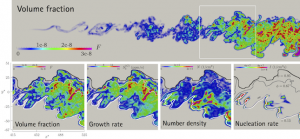Details
The formation of particles from supersaturated vapor is a fundamental process in aerosol-laden flows, both in nature and in technological applications. Examples of environmental flows include clouds and atmospheric aerosols. In the chemical processing industry, the condensation of a metallic chloride into monodisperse liquid droplets by mixing with a cold inert gas is a preliminary step in the production of powders for advanced ceramics.
In typical flow configurations, the condensing vapor concentration and temperature fields are not homogeneous in space. Local vapor supersaturation therefore occurs through fluid, heat, and mass transport. The nucleation and growth rates of particles are highly nonlinear and strongly influenced by local temperature and vapor concentration. As a result, issues related to the coupling between the spatially inhomogeneous mixing field and the aerosol microphysical processes are important.
Goals
- Understand the interaction between hydrodynamic mixing and aerosol growth in terms of timescales and length scales of the two processes. Various configurations are considered, ranging from one-dimensional opposed flows to complex three-dimensional mixing layers and homogeneous isotropic turbulence.
- Establish an experimental database on the interaction of aerosols and mixing by focusing on canonical fluid flow configurations and applying state-of-the-art diagnostics.
- Develop models and closures for Large Eddy Simulation/Reynolds Average Navier-Stokes modeling of aerosol flows.
Methods
Several numerical simulations are performed to achieve the goals of the project. In one part of project, we developed a one-dimensional code to simulate the nucleation, growth, and coagulation of droplets of a condensable vapor (e.g. dibutyl phthalate) in a mixing layer formed via a counter-flow setup. The condensable aerosol evolution in a turbulent mixing layer was simulated using the supercomputer “Shaheen” at KAUST.
Our simulation combines Direct Numerical Simulation (DNS) for fluid dynamics, the quadrature method of moments for aerosol dynamics, and a Lagrangian particles scheme to handle the aerosol moments’ convection. DNS fully resolves the turbulent flow, without empirical turbulent models. The quadrature method of moments for aerosol dynamics is numerically economical, making it feasible computationally to couple it with DNS. The Lagrangian particles scheme avoids the numerical difficulties of the moments’ convection in conventional convection schemes.
At present, two experimental setups are under development to complement the numerical simulations. The first is a counterflow system to study laminar conditions and the second was is a round jet setup to analyze the condensation in a turbulent flow.
Results
Results of the simulation of DBP aerosol dynamics in turbulent spatially evolving mixing layers were analyzed as follows. The statistics of aerosol quantities, such as number density, volume fraction, mean diameter, and surface density were conditioned with respect to mixture fraction, upon which aerosol growth rates depend. The conditional statistics show that the mean number density peaks at the location of most intense nucleation near the cold interface. The effect of turbulent fluctuations on the conditional statistics of growth rates is minimal, due to negligible vapor consumption. Conversely, the conditional statistics of number density and volume fraction display large scatter, pointing to the importance of turbulent transport and related drift of aerosol particles in mixture fraction space.

The rapid variation of temperature and vapor concentration due to intermittent mixing results in sudden changes in the nucleation and growth rates along the trajectory of aerosol parcels. This variation is due to differential diffusion effects between aerosol particles and gas-phase scalars, so that aerosol particles drift in mixture fraction space. The drift in the turbulent flow field is investigated quantitatively using the Lagrangian statistics of the material derivative of the mixture fraction. The occurrence of drift against mean mixing is key in explaining the presence of aerosol droplets on the hot and humid side of the mixing layer, where the rate of particle growth is highest. Thus, the spatial distribution of condensing aerosols in turbulent flows is shown to be fundamentally different from that found in laminar flows, which lack fluctuating mixing fields.
Relevant references
- A Alshaarawi, and F Bisetti. The effect of mixing rates on the formation and growth of condensation aerosols in a model stagnation flow”. J. Aerosol Sci. (2015) [Under review].
- Zhou, A Attili, A Alshaarawi, and F Bisetti. Simulation of aerosol nucleation and growth in a turbulent mixing layer”. Phys. Fluids 16 (2014), p. 065106. doi:10.1063/1.4884789
